The Porous–Permeable Zones in Heterogeneous Carbonate Reservoirs: A Case Study from Amara Oilfield, Iraq †
Abstract
:1. Introduction
2. Method and Materials
3. Results
- Mishrif Formation (2880–3271) m: The upper part of this formation consists of limestone with a white to grey coloration that contains fractures and vugs and some types of stylolites with broken shells of some fossils, while the lower part is characterized by a semi-brown limestone that contains a fragment of fossilized shells such as foraminifera.
- Khasib Formation (2852.1–2908.2) m;
- Mishrif Formation (2920.1–2999.8) m;
- Yamama Formation (4404.3–4404.3) m.
4. Discussion
5. Conclusions and Recommendations
- The two borewells from the Amara oilfield, Am1 in the west and Am3 in the east, were studied in detail using helium porosity and a micro-permeameter based on the lithology of core samples.
- More than 1800 measurements of porosity and permeability processed through three software products (Surfer, Grapher, and MATLAB) were used to perform vertical and horizontal reservoir characterization in two- and three-dimensional forms.
- The data regarding the porosity–permeability relationship show three porous–permeable zones in Am1 and Am3.
- The porosity–permeability information from the Am1 data was obtained from the Mishrif Formation, while the porosity–permeability information from the Am3 data was obtained from the Khasib, Mishrif, and Yamama formations.
- The reservoirs in the studied subsurface wells were significantly dominated by heterogenous carbonate rocks, where the lithologically controlled porosity–permeability zones were the main parameters used to model the reservoir characteristics from the western to eastern regions of the Amara oilfield.
- The values of porosity (29.6%) and permeability (591 md) in Am1 from the west were higher than those of Am3 from the east (where porosity is as much as 24.2% and permeability as much as 352 md). This finding is linked to dissolution and the opening system due to the extensive prevalence of vugs and pore spaces in carbonate reservoir rocks.
- The appearance of vugs and open spaces due to dissolution and especially diagenesis are the main reasons for the reductions and increments in the distribution of porous–permeable media under subsurface conditions.
- The conceptual modelling of the Amara oilfield from east to west based on two- and three-dimensional lattice settings shows that the reservoir characterization and porous–permeable zone in Am1 presented higher porous–permeable values than Am3 in the west of the Amara oilfield. Therefore, the porosity–permeability zones decrease from east to west; however, few fluctuations in the rising and falling of the porosity and permeability values were mostly controlled by a diagenetic open system or the heterogeneity of carbonate rocks in the area.
- The data reported herein confirm that the use of packages of logs and facies analysis to perform reservoir characterization in the previous studies was insufficient without a detailed study of carbonate heterogeneity using an optical microscope and other laboratory measurements.
- A recommendation for future studies on subsurface reservoir rock is to develop a higher-resolution model for reservoir characterization by utilizing the most sophisticated and micro-scaled tools, such as SEM, EDX, and ICP-M.
Supplementary Materials
Author Contributions
Funding
Institutional Review Board Statement
Informed Consent Statement
Data Availability Statement
Conflicts of Interest
References
- Akbar, M.N.A. New approaches of porosity-permeability estimations and quality factor Q characterization based on sonic velocity, critical porosity, and rock typing. In Proceedings of the SPE Annual Technical Conference and Exhibition. Society of Petroleum Engineers (SPE), Calgary, AB, Canada, 30 September–2 October 2019. [Google Scholar]
- Rahmouni, A.; Boulanouar, A.; Sebbani, J. Relationships between porosity and permeability of calcarenite rocks based on laboratory measurements. J. Mater. Environ. Sci. 2014, 5, 931–936. [Google Scholar]
- Ma, S.; Morrow, N.R. Relationships between porosity and permeability for porous rocks. In Proceedings of the International symposium of the Society of Core Analysts, Laramie, WY, USA, 8–10 September 1996; pp. 8–10. [Google Scholar]
- Salih, N.; Mansurbeg, H.; Kolo, K.; Préat, A. Hydrothermal carbonate mineralization, calcretization, and microbial diagenesis associated with multiple sedimentary phases in the upper cretaceous bekhme formation, Kurdistan region Iraq. Geosciences 2019, 9, 459. [Google Scholar] [CrossRef]
- Ehrenberg, S.N.; Eberli, G.P.; Keramati, M.; Moallemi, S.A. Porosity-permeability relationships in interlayered limestone-dolostone reservoirs. Am. Assoc. Pet. Geol. Bull. 2006, 90, 91–114. [Google Scholar] [CrossRef]
- Salih, N.; Mansurbeg, H.; Kolo, K.; Gerdes, A.; Préat, A. In situ U-Pb dating of hydrothermal diagenesis in tectonically controlled fracturing in the Upper Cretaceous Bekhme Formation, Kurdistan Region-Iraq. Int. Geol. Rev. 2020, 62, 2261–2279. [Google Scholar] [CrossRef]
- Bohnsack, D.; Potten, M.; Pfrang, D.; Wolpert, P.; Zosseder, K. Porosity–permeability relationship derived from Upper Jurassic carbonate rock cores to assess the regional hydraulic matrix properties of the Malm reservoir in the South German Molasse Basin. Geotherm. Energy 2020, 8, 12. [Google Scholar] [CrossRef]
- Croizé, D.; Renard, F.; Gratier, J.P. Compaction and Porosity Reduction in Carbonates: A Review of Observations, Theory, and Experiments. In Advances in Geophysics; Academic Press Inc.: Cambridge, MA, USA, 2013; pp. 181–238. [Google Scholar] [CrossRef]
- Sadooni, F.N. Stratigraphy, depositional setting and reservoir characteristics of Turonian—Campanian carbonates in central Iraq. J. Pet. Geol. 2004, 27, 357–371. [Google Scholar] [CrossRef]
- He, L.; Zhao, L.; Li, J.; Ma, J.; Lui, R.; Wang, S.; Zhao, W. Complex relationship between porosity and permeability of carbonate reservoirs and its controlling factors: A case study of platform facies in Pre-Caspian Basin. Pet. Explor. Dev. 2014, 41, 225–234. [Google Scholar] [CrossRef]
- Iscan, A.G.; Kok, M.V. Porosity and permeability determinations in sandstone and limestone rocks using thin section analysis approach. Energy Sources Part A Recovery Util. Environ. Eff. 2009, 31, 568–575. [Google Scholar] [CrossRef]
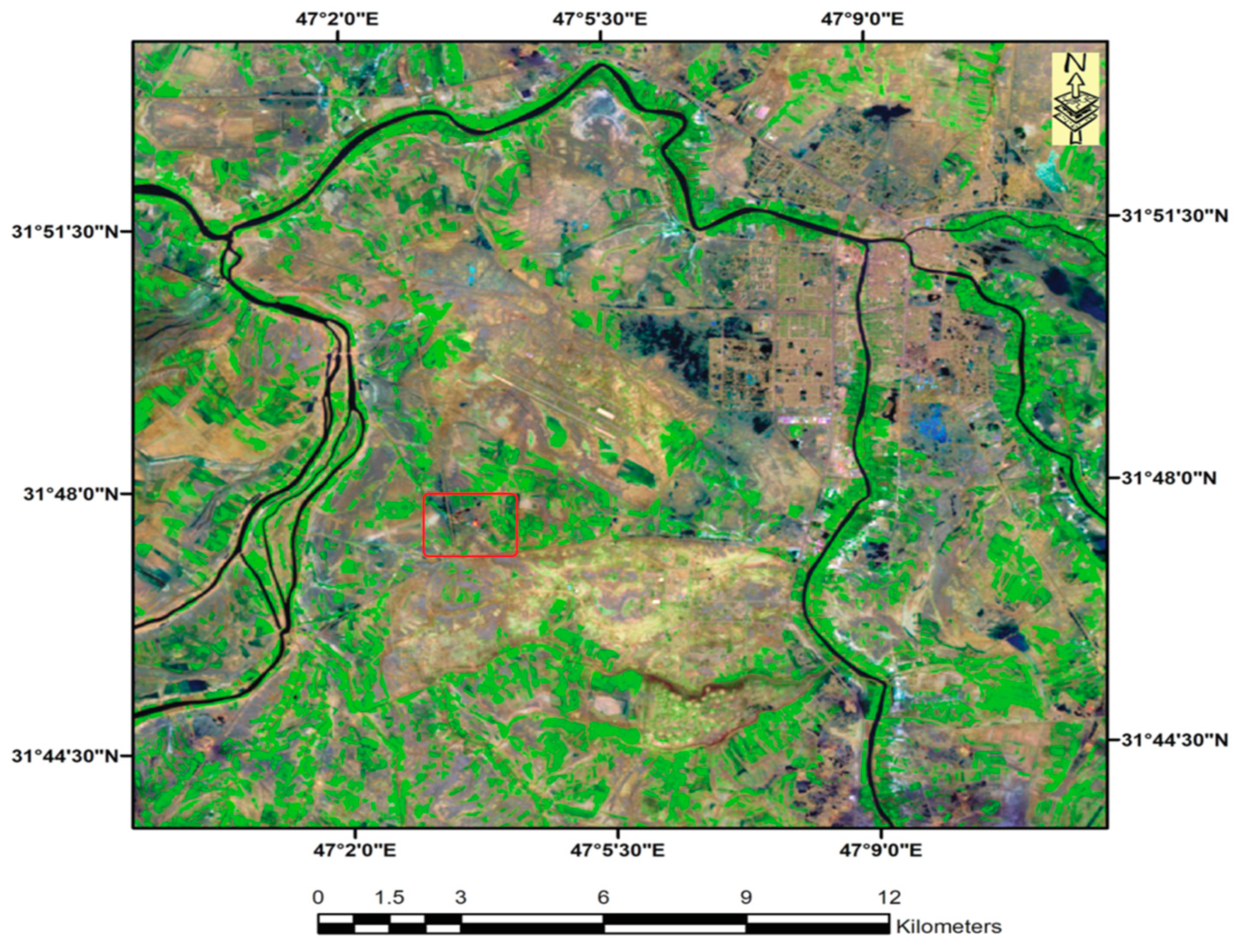
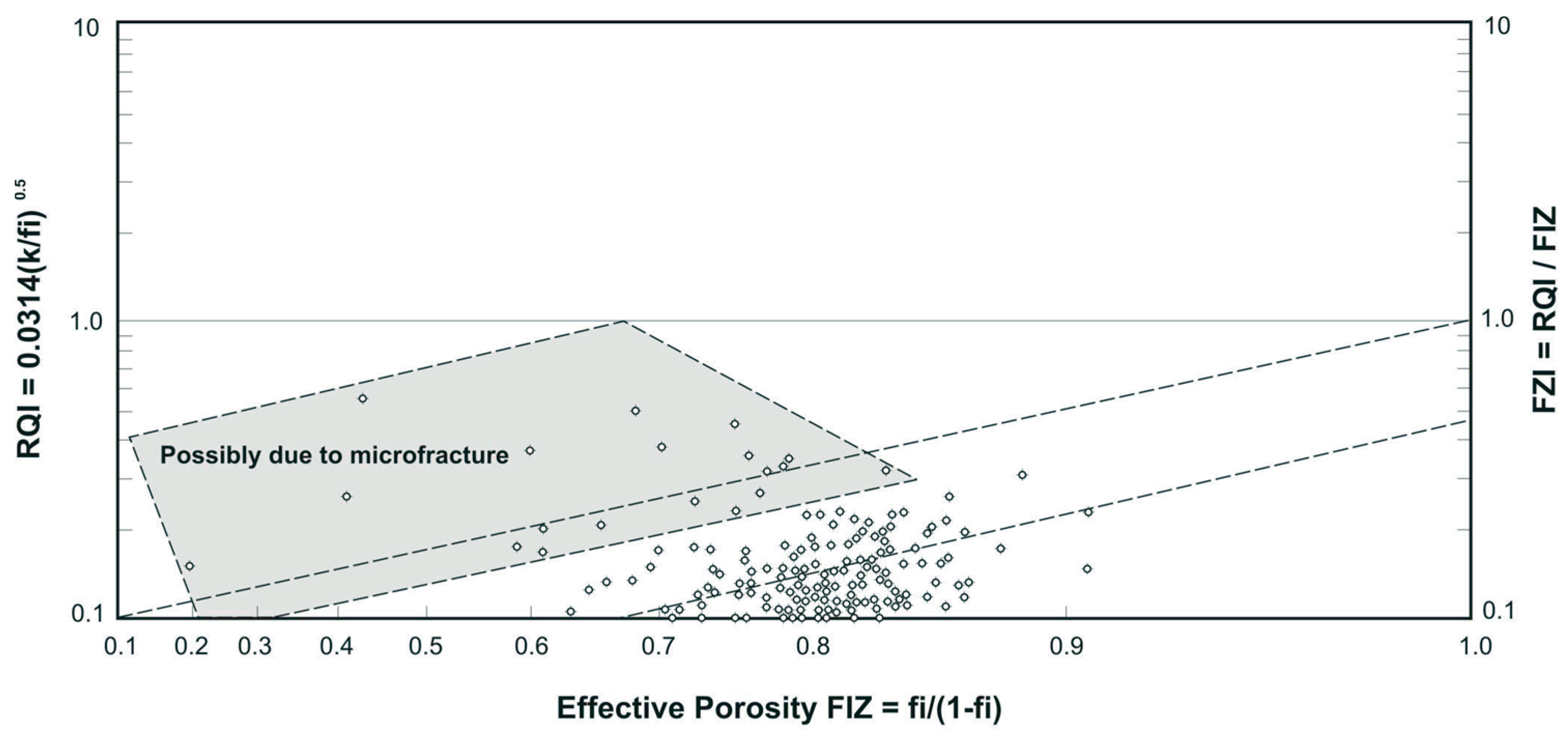


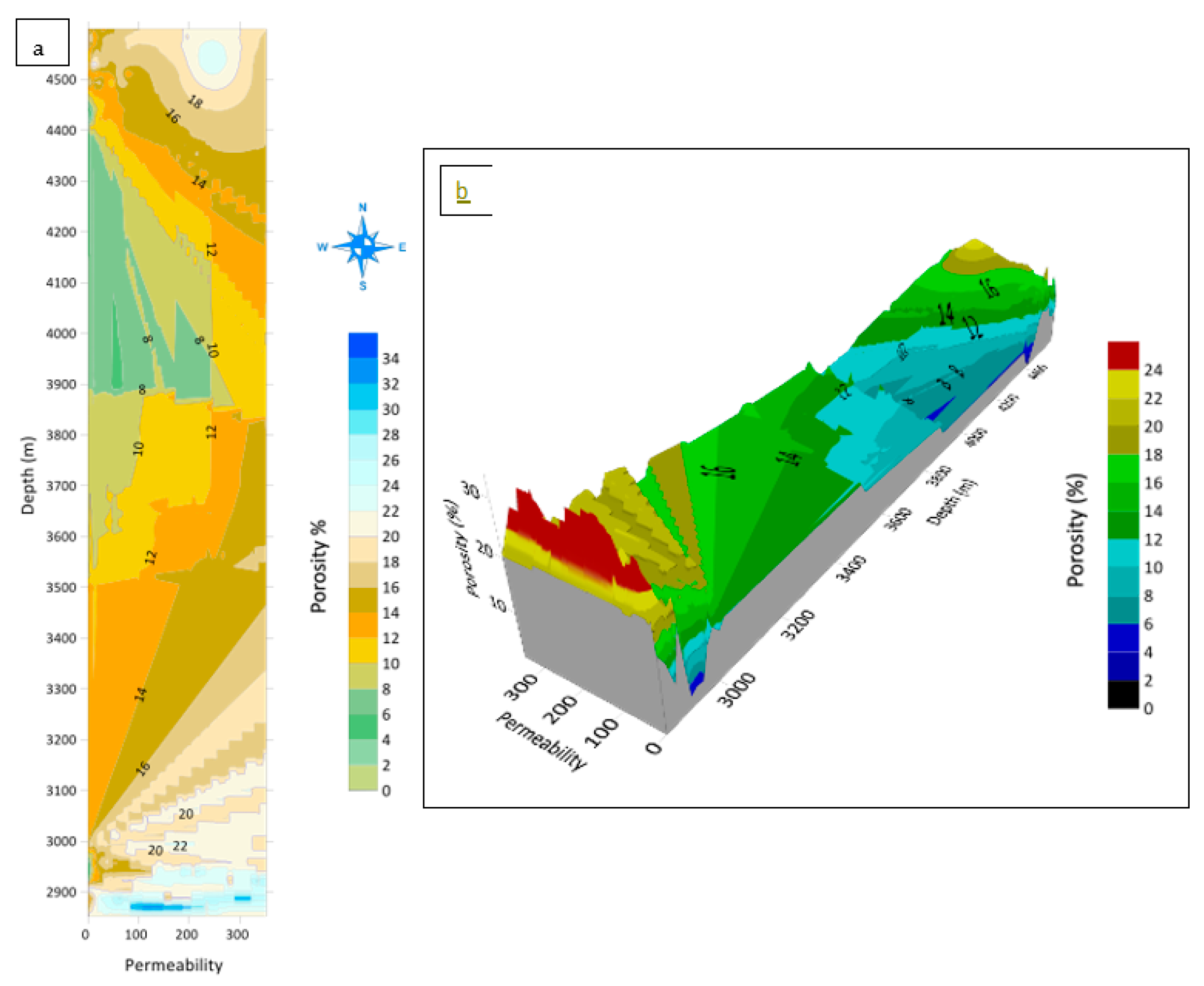
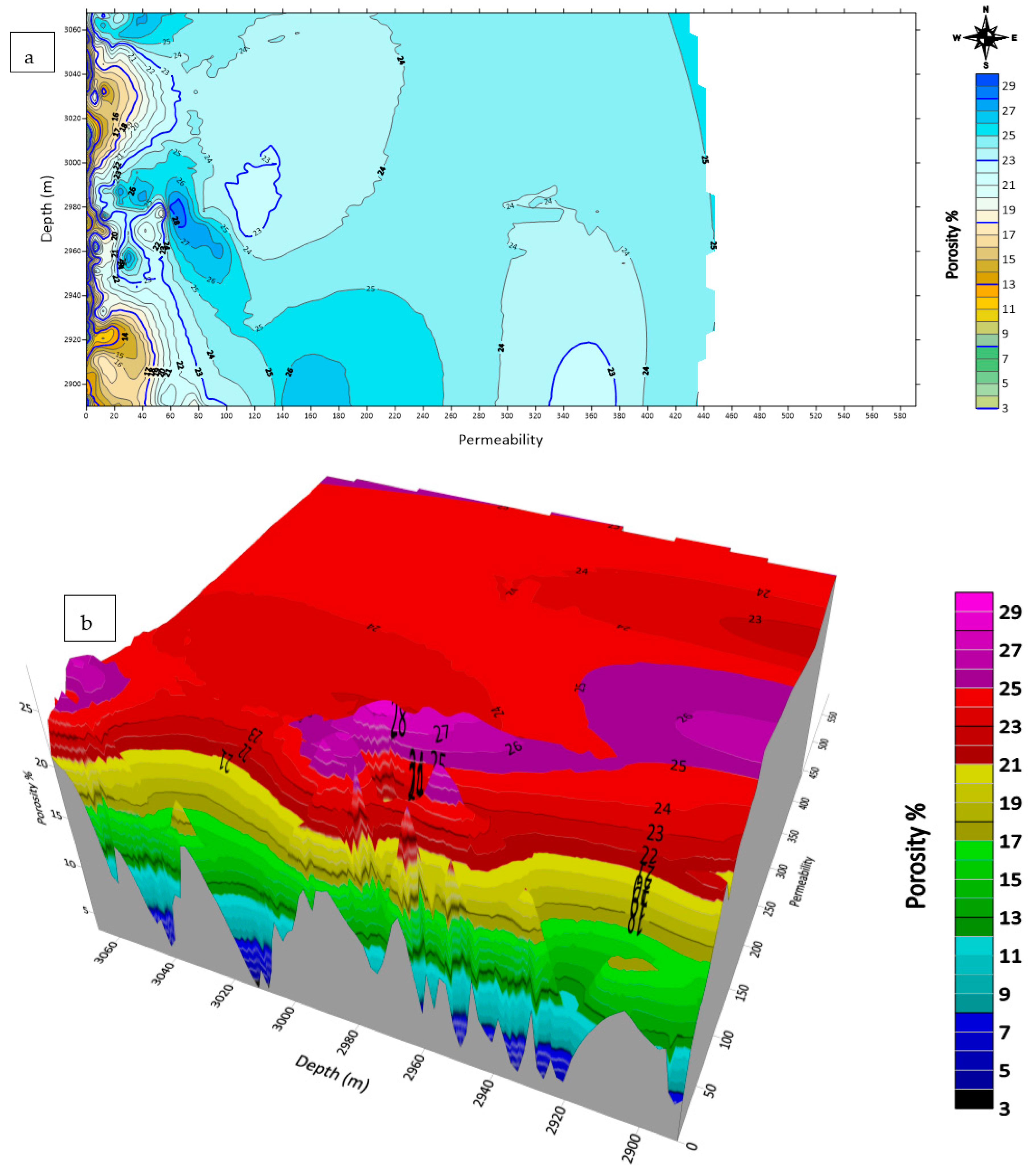
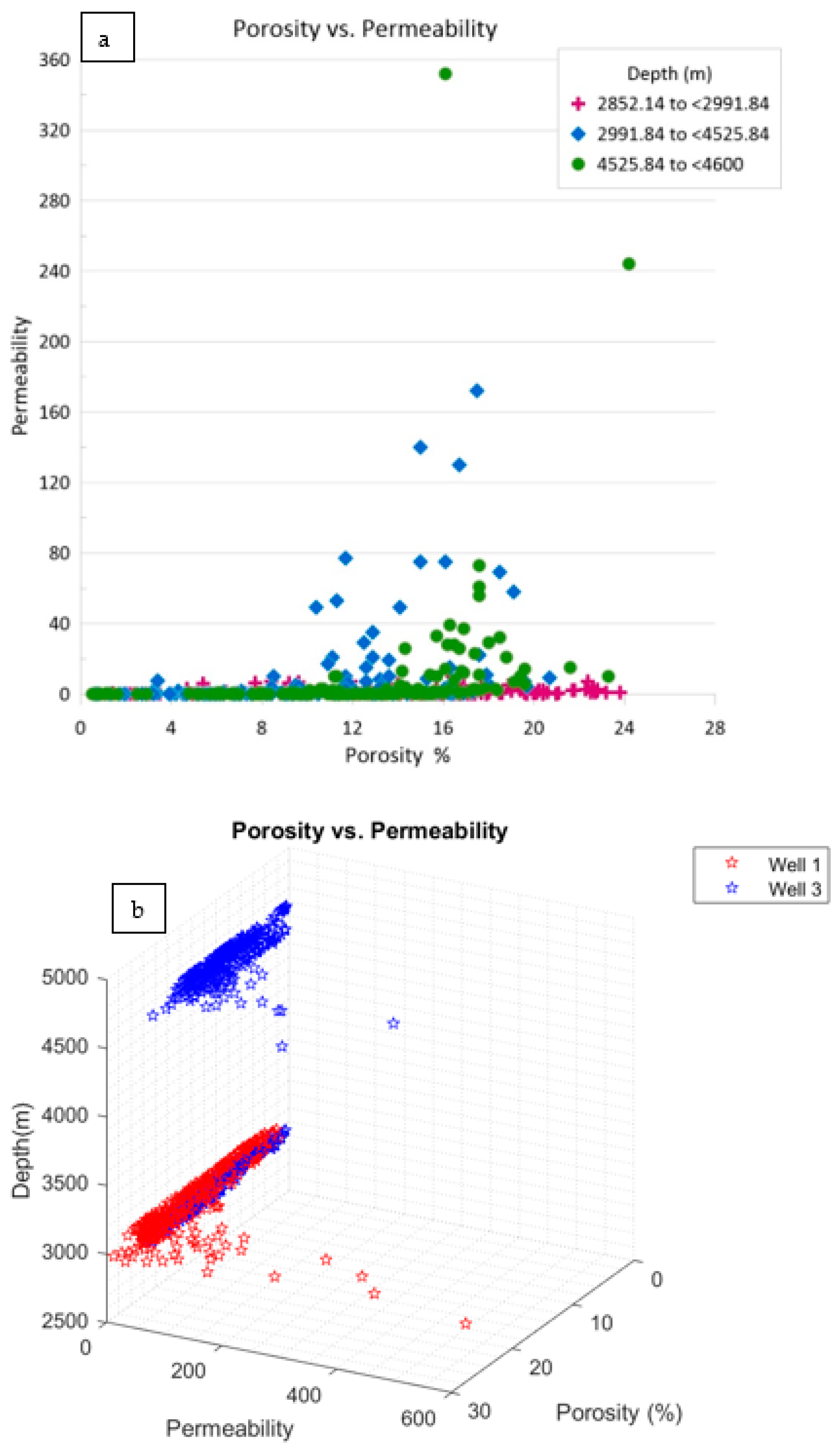
Disclaimer/Publisher’s Note: The statements, opinions and data contained in all publications are solely those of the individual author(s) and contributor(s) and not of MDPI and/or the editor(s). MDPI and/or the editor(s) disclaim responsibility for any injury to people or property resulting from any ideas, methods, instructions or products referred to in the content. |
© 2023 by the authors. Licensee MDPI, Basel, Switzerland. This article is an open access article distributed under the terms and conditions of the Creative Commons Attribution (CC BY) license (https://creativecommons.org/licenses/by/4.0/).
Share and Cite
Salih, N.M.; Al-Majmaie, S.M.; Muhammad, Z.A. The Porous–Permeable Zones in Heterogeneous Carbonate Reservoirs: A Case Study from Amara Oilfield, Iraq. Proceedings 2023, 87, 35. https://doi.org/10.3390/IECG2022-13965
Salih NM, Al-Majmaie SM, Muhammad ZA. The Porous–Permeable Zones in Heterogeneous Carbonate Reservoirs: A Case Study from Amara Oilfield, Iraq. Proceedings. 2023; 87(1):35. https://doi.org/10.3390/IECG2022-13965
Chicago/Turabian StyleSalih, Namam M., Shireen Mansour Al-Majmaie, and Zana Abdulla Muhammad. 2023. "The Porous–Permeable Zones in Heterogeneous Carbonate Reservoirs: A Case Study from Amara Oilfield, Iraq" Proceedings 87, no. 1: 35. https://doi.org/10.3390/IECG2022-13965
APA StyleSalih, N. M., Al-Majmaie, S. M., & Muhammad, Z. A. (2023). The Porous–Permeable Zones in Heterogeneous Carbonate Reservoirs: A Case Study from Amara Oilfield, Iraq. Proceedings, 87(1), 35. https://doi.org/10.3390/IECG2022-13965





